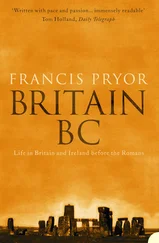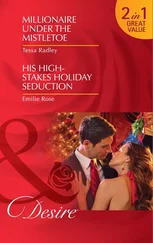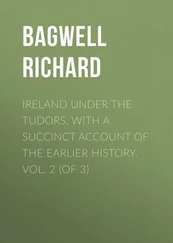Richard Bagwell - Ireland under the Tudors. Volume 3 (of 3)
Здесь есть возможность читать онлайн «Richard Bagwell - Ireland under the Tudors. Volume 3 (of 3)» — ознакомительный отрывок электронной книги совершенно бесплатно, а после прочтения отрывка купить полную версию. В некоторых случаях можно слушать аудио, скачать через торрент в формате fb2 и присутствует краткое содержание. Жанр: foreign_antique, foreign_prose, на английском языке. Описание произведения, (предисловие) а так же отзывы посетителей доступны на портале библиотеки ЛибКат.
- Название:Ireland under the Tudors. Volume 3 (of 3)
- Автор:
- Жанр:
- Год:неизвестен
- ISBN:нет данных
- Рейтинг книги:3 / 5. Голосов: 1
-
Избранное:Добавить в избранное
- Отзывы:
-
Ваша оценка:
- 60
- 1
- 2
- 3
- 4
- 5
Ireland under the Tudors. Volume 3 (of 3): краткое содержание, описание и аннотация
Предлагаем к чтению аннотацию, описание, краткое содержание или предисловие (зависит от того, что написал сам автор книги «Ireland under the Tudors. Volume 3 (of 3)»). Если вы не нашли необходимую информацию о книге — напишите в комментариях, мы постараемся отыскать её.
Ireland under the Tudors. Volume 3 (of 3) — читать онлайн ознакомительный отрывок
Ниже представлен текст книги, разбитый по страницам. Система сохранения места последней прочитанной страницы, позволяет с удобством читать онлайн бесплатно книгу «Ireland under the Tudors. Volume 3 (of 3)», без необходимости каждый раз заново искать на чём Вы остановились. Поставьте закладку, и сможете в любой момент перейти на страницу, на которой закончили чтение.
Интервал:
Закладка:
The spot where Desmond was decapitated is marked by a mound, and retains the name of Bothar-an-Iarla , or the Earl’s way. A gigantic elder formerly overshadowed the place, and in our own day it is covered by a young oak, a holly, and a bright tangle of ferns and foxgloves. A good carriage-road runs through the once inaccessible glen, and marks the difference between the sixteenth and nineteenth centuries. Desmond’s death closes the mediæval history of Munster, and it is no wonder that much legendary glory attaches to his name. He was a man of little talent or virtue, though he need not be too severely condemned for refusing to see that the days of feudal or tribal independence were over. But the past has an irresistible attraction for Irish sentiment, and the popular ear is more readily opened to fable than to historical truth. With nothing heroic about him, the unhappy Earl is still honoured as a hero; but even the fidelity of tradition to his memory is less than that of the natives to him while he yet lived. Let thus much be said in honour of the poor kerne, who stood so staunchly in a doubtful cause. The Earl’s ghost, mounted on a phantom steed with silver shoes, is said sometimes to rise at night from the waters of Lough Gur; and when the west wind comes up fitfully from the sea and makes slates and windows rattle, the Kerry people still call upon travellers to listen to the Desmond howl. 106 106 The spot where Desmond fell is on the right bank, rather low down in the glen. No doubt the cabin where he spent the night was higher up. In the survey made by Sir Valentine Browne and others, and privately printed by Mr. S. M. Hussey, is the following passage: ‘A great wood here and there, filled with oak-trees fit for house timber, but not large enough for the making of ships and castles. But the greater part of the said wood consists in underwood of the age of fifty and sixty years, filled with dotted trees – ash, hazels, sallows, willows, alders, birches, white-thorns and such like… The wood is called Glanageenty, in which the late Earl of Desmond was slain in his rebellion, containing in length about four miles, and in breadth two miles, which said woods, because no woods there are saleable, and they lie under the mountains of Slew-Logher, far from any river or navigable stream, are here valued at nil .’ I inspected the ground in June 1883.
CHAPTER XL.
GOVERNMENT OF PERROTT, 1583-1584
As early as December 1582, Sir John Perrott had been spoken of as Grey’s successor. His actual appointment was, however, deferred for more than a year, Loftus and Wallop continuing to act as Lords Justices till June 1584. They were fortunate in seeing the end of the Desmond rebellion, but less so in having to deal with those who had been engaged in it. Lady Desmond, in her poverty, subsisted upon a pension allowed her by Ormonde, until the Queen’s pleasure should be known; and the protections which he had given to the seneschal of Imokilly, Patrick Condon, and other leaders, were respected. Wallop did not like the Lord-General, but he did not thwart him seriously. Piers Grace, an old and notorious offender in the Kilkenny district, was pardoned at the Earl’s intercession, and the Lords Justices observed that they would not have done it for anyone else. 107 107 Birch’s Memoirs , i. 27; Ormonde to Burghley, Jan. 26, 1584; Lords Justices to Ormonde, Dec. 31, 1583.
In 1581, after the death of Fitzgibbon, Gregory XIII. appointed Dermod O’Hurley to the Archbishopric of Cashel. He had spent fifteen years at Louvain and four at Rheims, and he was deeply engaged in the plans of Irish exiles against Elizabeth’s government. We get a glimpse of him at Rome not long after his appointment, and find him, like his predecessor, occupied in schemes for the invasion of Ireland. The caution of the Italian ecclesiastic is, as usual, contrasted with the sanguine temper of the exiles. Christopher Barnewall, who had been sent to the Continent by Baltinglas, was introduced by O’Hurley to Cardinal Como, and informed him that Kildare and Delvin were in prison, though both had served against the Wicklow rebels. ‘Who,’ said the Cardinal, with an expressive shrug, ‘would trust an Irishman? The Earl promised to take our part.’ O’Hurley thought he had not gone so far. ‘Wilt thou tell me?’ answered the Italian angrily, and produced a letter from Kildare and a document signed by most of the Lords of Ulster, Munster, and Connaught, which made his view good. ‘Do you think,’ he said, ‘that we would have trusted to James Fitzmaurice and Stukeley, or to all these lords which subscribed the great letter, unless we had received this letter from the Earl of Kildare? The Pope has no money for any of your nation.’ 108 108 Second examination of Christopher Barnewall, Aug. 12, 1583.
O’Hurley landed at Drogheda in September, 1583, bringing letters from Rome with him. He was harboured by Lord Slane, whose daughter was married to Ormonde’s natural son Piers, and in the latter’s company he went into Munster after a few days’ rest. The Archbishop, who was soon hunted down, with Ormonde’s help, made no secret of having been engaged in the work of the Inquisition, and charged Kildare and Delvin with the late insurrection – thus showing that Barnewall had spoken truly. Walsingham recommended the use of ‘torture, or any other severe manner of proceeding, to gain his knowledge of all foreign practices against Her Majesty’s states.’ The Lords Justices objected that they had no rack nor other such instrument of terror, and that the Tower of London would be a fitter place for the experiment. Walsingham then advised them to toast the prisoner’s feet at the fire with hot boots. A commission was accordingly made out to Fenton and Waterhouse, and the ordeal was applied with frightful severity. The letters brought by O’Hurley had been intercepted, and could not therefore be denied, but nothing of importance was elicited. A letter which he had written to Ormonde was produced, and the Lords Justices took care to hint at the Earl’s complicity, but without effect. The lawyers held that an indictment for treasons committed abroad would not lie, and in any case a trial by jury was not to be risked. The Lords Justices suggested martial law, to which, as they grimly observed, the landless Archbishop could not fairly object. Seeing that further torture would be useless Walsingham agreed to this course, and noted the Queen’s ‘good acceptation of their careful travail in this matter.’ Throughout the correspondence it is evident that Elizabeth and all her servants looked upon O’Hurley mainly as a traitor and not as a recusant; and that defence of their conduct may stand for what it is worth. The torture is indefensible; but it was only too common in those days, and O’Hurley himself had been an Inquisitor. The Archbishop was hanged privately in the Castle early on June 19, after the arrival of Perrott, but before he had been sworn in. 109 109 The text is taken from the official correspondence, Lords Justices to Robert Beale, Oct. 8, 1583; to Walsingham, Oct. 20, Dec. 10, March 7 and 8, 1584, April 14, and July 9; Walsingham to the Lords Justices, April 28, 1584. It appears from the Catholic accounts that combustibles were poured into the boots. That of the Jesuit Holing, who died in 1599, may be taken as contemporary; it is printed in Spicilegium Ossoriense , i. 87. ‘Tormenta nova illi parantur; nam ejus pedibus atroces hæreticorum ministri ocreas, butiro, oleo, et sale oppletas, ac – quod longe crudelius fuit – crudo ex corio conditas subjecerunt; postea, vero, catenis simul et compedibus alligatum, aperto in loco, nempe in medio castri – ubi spectaculum mundo, hominibus, et angelis – ubi ab omnibus videri potuit, lento igne apposuerunt, illicque detinuerunt, donec ipso corio consumpto, butiro, oleo, et sale ferventibus, ossa non cute pro carne tecta verum etiam omnino munda fuerint relicta… Postea in ergastulum et obscurissimum carcerem reducitur, et post sex menses tanquam traditor et reus criminis læsæ majestatis, ab iniquo judice ad mortem condemnatus est. Ad extremum, post inaudita tormenta et carceris molestias, albescente cælo, ne forte tumultus fieret in populo qui ejus exemplo, doctrina, et constantia permotus ad ejus defensionem perveniret, ignorantibus civibus patibulo suspensus martyrium consummavit Dublinii circa annum 1585, mense Maio.’ Other accounts, which agree in essentials, are collected in Brady’s Episcopal Succession , ii. 11, 599. The Valicellian MS. there quoted, says a withen rope was used to protract his agony; but Bacon tells us that this kind of halter was generally used in Ireland, and that a rebel objected to any other.
Интервал:
Закладка:
Похожие книги на «Ireland under the Tudors. Volume 3 (of 3)»
Представляем Вашему вниманию похожие книги на «Ireland under the Tudors. Volume 3 (of 3)» списком для выбора. Мы отобрали схожую по названию и смыслу литературу в надежде предоставить читателям больше вариантов отыскать новые, интересные, ещё непрочитанные произведения.
Обсуждение, отзывы о книге «Ireland under the Tudors. Volume 3 (of 3)» и просто собственные мнения читателей. Оставьте ваши комментарии, напишите, что Вы думаете о произведении, его смысле или главных героях. Укажите что конкретно понравилось, а что нет, и почему Вы так считаете.












